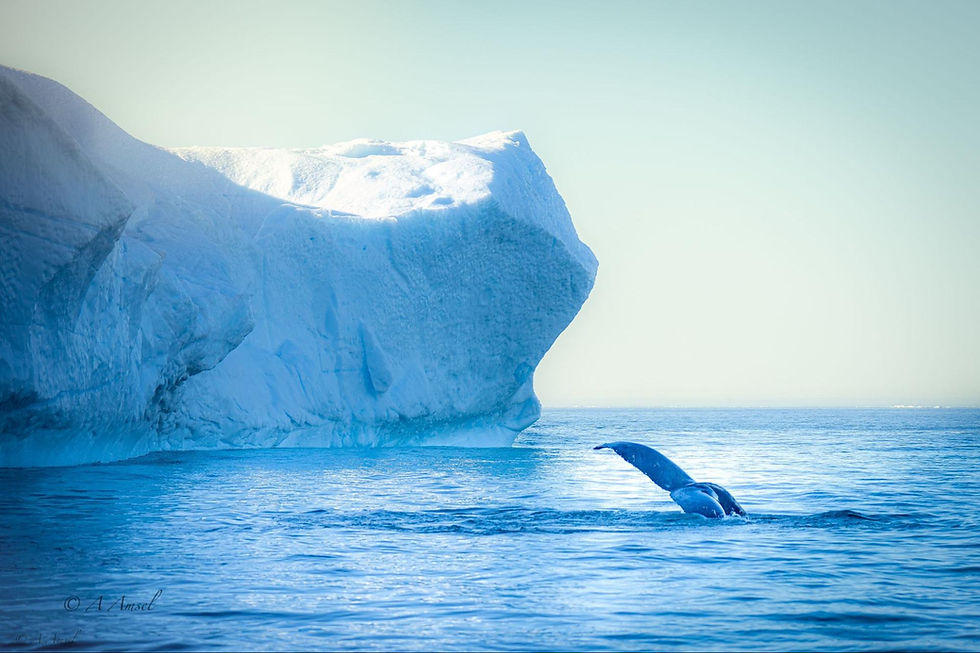From Fluke to Breath: How Whales Keep Our Planet Alive (And How Your Photos Can Help Conservation)
- Anthony Amsel

- Jul 21
- 4 min read

When we think of whales, we often picture their massive tails crashing through the waves or imagine the haunting beauty of their underwater songs echoing in the deep. These ocean giants stir our imagination—and for good reason. But beyond their size and mystique, whales play a surprising and essential role in keeping our planet healthy. They’re not just majestic creatures of the sea—they’re powerful players in the fight for a thriving Earth.
In fact, whales are what scientists call ecosystem engineers: animals that shape their environment in ways that benefit many other species. And one of the most fascinating examples of this is something called the “whale pump.” It may not sound glamorous, but it’s one of the ocean’s most quietly powerful natural processes.
So what is it?
How Whales Impact Ocean Ecosystems
Well, whales feed in all sorts of ways depending on the species. Some dive deep in search of squid, while others skim the surface for krill and small fish. But no matter how or where they feed, all whales have to surface to breathe. And when they do, they release waste – yes, poop. But here’s the amazing part: that waste is packed with nutrients like nitrogen, phosphorus, and iron; elements that are often in short supply near the surface of the ocean, where sunlight fuels life.
Whale Feeding and the Essential Nutrient Cycle
This is where the “whale pump” kicks in. By bringing nutrients up from the deep and releasing them in the sunlit waters, whales essentially fertilize the ocean. Their poop helps spark blooms of phytoplankton: tiny, plant-like organisms that drift through the upper layers of the sea.
Phytoplankton may be microscopic, but don’t let their size fool you – they’re some of the most important organisms on the planet. They sit at the base of the marine food web, feeding everything from zooplankton to fish to, yes, whales themselves. But even more impressively, phytoplankton produce over 50% of the oxygen in Earth’s atmosphere. That’s more than all the world’s forests combined.
So yes, every second breath you take is thanks, in part, to the ocean, and to whales.

It’s a powerful reminder that even the largest animals on Earth are deeply connected to the smallest. And by supporting the tiniest life in the sea, whales help keep the planet breathing. It’s nature’s perfect feedback loop: whales fertilize phytoplankton, phytoplankton feed the ocean and give us oxygen, and the cycle continues.
But that balance is becoming increasingly fragile.
Why Protecting Whale Populations Is Crucial for Ocean Health
Whales, once pushed to the edge of extinction by commercial whaling, are still recovering and still facing serious threats. Today, these animals must navigate a world of increasing human pressure: ship strikes, entanglement in fishing gear, plastic pollution, noise disturbance, habitat degradation, and the growing impacts of climate change. As whale populations decline or shift, so too does the whale pump and the cascading benefits it brings to ocean life and global systems.
That’s why conservation matters more than ever. And thankfully, you don’t have to be a marine biologist to make a real difference.
The Role of Citizen Science in Whale Conservation: How Your Photos Make a Difference
Enter Happy Whale, a citizen science platform that turns everyday whale sightings into critical scientific data. Here’s how it works: when you spot a whale and snap a photo, especially of its fluke (the underside of the tail), you can upload that image to Happy Whale’s website. Using photo-identification software, the platform compares your image to a growing global database of known individual whales.

Each whale’s fluke is like a fingerprint; unique in its shape, coloration, and markings. If there’s a match, you'll get to learn more about that individual whale—where it’s been spotted before, what species it is, and how it fits into larger population studies. Even if there's no match yet, your photo becomes part of a record that researchers can use down the line.
Happy Whale: Turning Whale Sightings into Conservation Data
The simple act of sharing a photo helps scientists track whale movements across entire oceans, understand migration routes, monitor population health, and identify areas that are critical for protection. It’s a brilliant example of citizen science in action with real people contributing real data that supports real conservation.
The data collected through Happy Whale has already been used in scientific publications, conservation planning, and international monitoring efforts. It’s helping to paint a clearer picture of whale populations around the world—one photo at a time.
So the next time you’re lucky enough to see a whale, whether on a boat, from a beach, or even in an old vacation photo, remember that your sighting can mean something more. It’s not just a moment of wonder, it’s a chance to contribute to the science and protection of one of Earth’s most important animals.
And the next time you take a deep breath, think of the whales. Their quiet work beneath the waves isn’t just beautiful, it helps keep our planet alive. And thanks to tools like Happy Whale, you can be part of that story.

About the Author
Anthony is a wildlife photographer and naturalist with a background in biology and expedition leadership, specializing in remote northern landscapes. Through powerful storytelling and photography, he raises awareness of conservation issues and inspires meaningful connection to nature.





Comments